

OK, so you want to find out when your Höfner archtop or
thinline was made? That can either be a very quick and simple process, or it may
well be long, tedious, and ultimately far from precise. It all depends on the
period of your guitar’s manufacture, which model it is (whether it had a long or
a short production run), and who the distributor/wholesaler was!
The following are all pieces of information that may be
of use in establishing a manufacture date for your guitar:
·
Serial numbers
·
Pot codes
(indicating when any potentiometers incorporated in the electrics of a guitar
were made.
·
Body dates –
dates are sometimes written or stamped inside the guitars body cavity.
·
Types of pickups fitted
·
Specific features in the design or specification
of the guitar that were only used during one particular time period.
First though, can we even define
what a guitar’s “manufacture date” is?
Is it the date when the body was made, even
though Höfner had a habit of making guitar bodies in batches, putting these into
stock maybe for a year or two, and then assembling and finishing them when the
orders came in? Perhaps it is the date when the potentiometers for the volume
controls were made, even though these were produced again in batches in a
supplier’s workshop and then delivered to Höfner who immediately put them into
the stock room for anything between a few weeks or a few years. No, using either
body dates or “pot codes” would seem a rather silly way of defining the exact
manufacture date of one’s guitar, although they are very good indication of
approximate dates. It is surprising though how many owners (and vendors) do
proclaim that their guitar was made on a particular day or week of a particular
year, after reading the body date and/or pot codes.
A more definite date is that when the final assembly of
the guitar is completed. However, until Höfner started using serial numbers
which were based on the “signing-off” date following final assembly, there were
no means of accurately arriving at that date.
Shipping records, including
invoices, are the next best thing, providing however one assumes that Höfner
didn’t have guitars hanging around the workshops for any great length of time
after completion. After all, it doesn’t seem likely that Höfner would put the
effort into finishing a guitar just to have it then sitting about instead of
producing cash flow. The problem is that unless a guitar has a serial number,
then how does one identify on an invoice as to when it was shipped? That is
where the Selmer London guitars have the advantage in the dating game. Höfner
put the serial numbers on the instruments on behalf of Selmer, and then recorded
these on their shipping records as each instrument set off to Selmer. That is
how we now know,
to a modest degree of accuracy,
the dates when most guitars were shipped to Selmer.
So what’s the answer if one doesn’t own a
Selmer–distributed guitar? Well, I didn’t say that we should disregard body
dates or “pot codes” did I? It’s just that we should take care not to get too
carried away with them, but use them as another piece of evidence to be used in
conjunction with other items of evidence such as design features and detail of
specification apparent on the guitar. If nothing else however, they give dates
which should be considered as the very earliest possible that the guitar could
have been assembled.
So, dating has to be perhaps considered as an art rather
than a science. Occasionally one will be able to arrive with a confident
conclusion that one’s guitar was definitely made in a particular year. More
usually however, it will be a case of deciding on a particular time period which
may span two or three years, one half of a decade, or even a decade. One has
then to accept that this will be the best that can be achieved and simply live
with that conclusion.
So, let’s see what can be gleaned from the list of five
sources of dating information listed above:
Manufacturers’ serial numbers are usually the simplest
and most reliable way of accurately dating a guitar. Unfortunately, that is not
the case with Höfner-made guitars and bass guitars! As can be seen from the
information below, most Höfner guitars made prior to 1985 have no serial
numbers. Many of those that do have numbers that are virtually useless as
regards to dating, and at best only give a vague clue to a possible manufacture
period. Unless one is lucky enough to own a guitar with a Selmer serial number,
or one made after 1985 or even better after 2000, then other features on the
guitar have to be considered in order to build up an increasing accuracy of a
probable manufacture date.
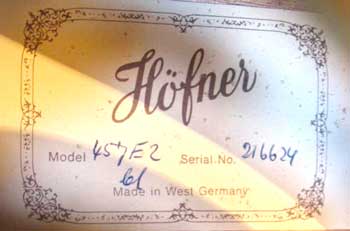

As a general rule, Höfner did not give serial numbers to
the majority of
their guitars or basses until 1976, when a 6-digit number system was introduced.
Unfortunately, these numbers do not follow a fully consecutive sequence although
they do seem to be used in blocks from 1976 to late 1979 and then late 1979 to
1984, so that does help a little. These 6-digit serial numbers were allocated to
each guitar on a body label located beneath the bass soundhole or by sticking a small white label with black numbers to the rear of
the headstock on those thinline guitars that did not have a soundhole. A few
examples of serial numbers of this type with approx. shipping dates are provided
below, not particularly to act as a comprehensive dating guide but more to show
the pitfalls of using this “system” is for dating
purposes.
|
Date |
Serial No. |
|
May 1976 |
401600 |
|
Sept 1979 |
403600 |
|
Nov 1979 |
208624 |
|
Oct 1980 |
210510 |
|
Oct 1981 |
212358 |
|
Dec 1982 |
214283 |
|
June 1983 |
214744 |
| Mar 1984 | 215676 |
|
1985 |
216624 |
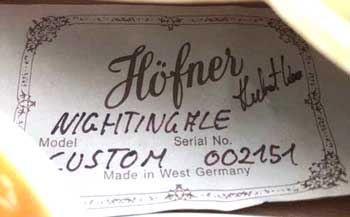
In 1985, it would appear that an attempt was made to
arrive at a system that would be based on the date that guitars were shipped
from the workshop. The system was again based on 6 numeric digits as follows:
1st
digit: last digit of the year (e.g. “6” for 1996)
2nd
& 3rd
digits: month of the year
(e.g.”11” for November)
4rd
& 5th
digits: day of the month (e.g. “07” for the seventh day)
6th
digit: the number of the guitar signed-off that day (e.g. “2” for the second
guitar signed-off”
So, a serial number 611072
would have been given to the second guitar signed off on the 7th
November 1996.
(Strangely, this system was not adopted for bass guitars
until 1996, which before that date were all numbered using the previous random
system. Even after 1996, some bass guitars continued to be numbered under the
old random system.)
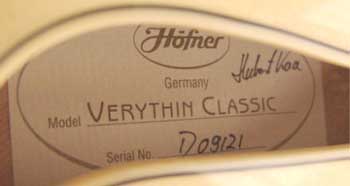
At the beginning of the year 2000, Höfner at last
adopted an overall and definitely more sensible system of serial numbers which
was still based on the date that the guitar was “signed-off” after completion,
but which ensured that duplication would not occur every ten years! Instead of
the first digit of the serial number being a number, a letter was used instead.
Therefore, Serial No. B09233 would indicate that the bass had been the third one
signed off on 23rd September 2001. The year letters for this system are provided
below:
|
Year |
Year Letter |
Year |
Year Letter |
Year |
Year Letter |
|
2000 |
A |
2006 |
G |
2012 |
N |
|
2001 |
B |
2007 |
H |
2013 |
P |
|
2002 |
C |
2008 |
J |
2014 |
|
|
2003 |
D |
2009 |
K |
2015 |
|
|
2004 |
E |
2010 |
L |
2016 |
|
|
2005 |
F |
2011 |
M |
2017 |
|
The numbers described above are written on a body label,
together with the model name and the signature of the luthier responsible for
assembling and signing-off the guitar. This is usually located inside the body,
directly below the bass sound hole or control panel for a guitar like the Club
re-issues without sound holes.
If Höfner didn’t have a serial
number system for their guitars and basses before the mid-1980’s, then what are
the numbers found at various locations on the headstocks of some of the earlier
guitars? Well, those are numbers applied by or on behalf of various Höfner
distributors around the World. Presumably those distributors felt that it was
important to have such a system whereby the provenance of each instrument could
be recorded and subsequently traced for such matters as warranty claims. The
best documented and hence the most useful are those of Selmer London.
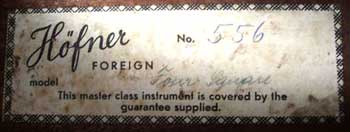 |
Very Early Label Type. c1952 |
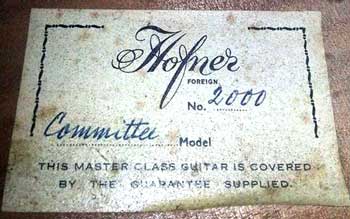 |
Early Label with Hand-Written Details c1953 - c1958 |
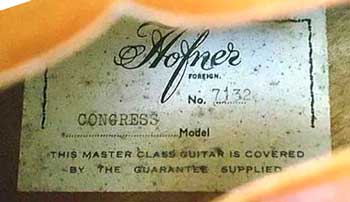 |
Label with Typed Details c1958 - c1972 |
Selmer London stipulated a separate series of numbers
for each Höfner model that they dealt with, and they insisted that Höfner put
serial numbered labels inside the bodies of their guitars under the bass sound
hole, or stamp the serial number on the back of each headstock for those few
guitars such as the Clubs that didn’t have sound holes. Höfner actually recorded
these numbers on their shipping records, and although these records were far
from complete, it was possible back in the 1990’s for the information to be
collated, resulting in tables correlating the serial numbers against the years
in which the basses were shipped. This work was carried out for, and first
appeared in, Michael Naglav’s excellent book entitled “Höfner-Guitars, Made in
Germany” which was published in the mid-1990’s. It has been expanded in the
tables below using the information gained over the years whilst compiling the
model registers on the Vintage Höfner website.
|
Model /Shipping Dates |
1952-53 | 1954 | 1955 | 1956 | 1957 | 1958 | 1959 | 1960 | 1961 | 1962 |
| Four Square | 500 - c1000 | |||||||||
| Square Dance | c2000 - c2300 | |||||||||
| Congress | c2300 - c2500 | c2500 - c3000 | c3000 - c3800 | c5800 - c7800 | c7800 - c8700 | c8700 - c9900 | c9900 - 10958 | 10959 - 12278 | ||
| Senator | 500 - c1000 | c1000 - c1350 | c1350 - c1900 | c1900 - c2700 | c2700 - c4400 | c4400 - c7800 | c7800 - c10000 | c10000 - c11400 | c11400 - 11702 | 11702 - c12080 |
| Senator Thinline | 500 - c950 | c950 - 1088 | 1089 - 1227 | 1228 - c1300 | ||||||
| President | 1500 - c1650 | c1650 - c2020 | c2020 - c2380 | c2380 - c2800 | c2800 - 3479 | 3480 - c5100 | c5100 - c6500 | c6500 - 7967 | 7968 - c8000 | c8000 - 8125 |
| President Thinline | >34 - c330 | c330 - 681 | 682 - c830 | |||||||
| Committee | 2001 - c2040 | c2040 - c2140 | c2140 - c2260 | c2260 - c2340 | c2340 - 2563 | 2564 - 2950 | 2951 - c3420 | c3420 - c3700 | c3700 - c3744 | 3745 - 3792 |
| Committee Thinline | 1001 - c1090 | c1090 - 1175 | 1176 - c1230 | c1230 - c1320 | ||||||
| Committee Deluxe | 101 - c120 | c120 - c130 | ||||||||
| Golden Hofner | 1 - c5 | c5 - ? | ? - c50 | c50 - c65 | ||||||
| Golden Hofner Thinline | 10 - 16 | 17 - c25 | ||||||||
| Verithin | 201 - 350 | 351 - 699 | 700 - 1238 | |||||||
| Club 40 | 100 - ? | ? - 254 | 255 - 420 | 421 - c925 | c925 - 1534 | 1535 - 1674 | 1675 - c1720 | |||
| Club 50 | 300 - ? | ? - 478 | 479 - 650 | 651 - c1225 | c1225 - 1779 | 1780 - c1900 | c1900 - c2000 | |||
| Club 60 | 100 - 180 | 181 - c850 | c850 - 1296 | 1297 - 1607 | 1608 - ? |
|
Model /Shipping Dates |
1963 | 1964 | 1965 | 1966 | 1967 | 1968 | 1969 | 1970 | 1971 | 1972 |
| Congress | 12278 - c13390 | c13390 - c14332 | c14332 - c14891 | c14891 - c15366 | c15141 - c15366 | c15366 - c15456 | c15456 - c15471 | c15471 - 15517 | c15517 - c15533 | c15533 - ? |
| Senator | c12080 - c12700 | c12700 - c13500 | c13500 - c13675 | c13675 - 13768 | ||||||
| Senator Thinline | c1300 - 1404 | 1405 - c1659 | c1660 - c1900 | c1900 - c2300 | ||||||
| Senator 66 | 100 - 194 | 195 - c325 | 326 - 405 | 406 - 459 | 460 - 468 | 469 - 489 | 486 - 569 | |||
| Senator 66 Thin | 1 - c90 | c91 - ? | ? - 189 | 190 - ? | ? - ? | ? - ? | ? - 193 | |||
| President | 8126 - c8330 | c8330 - 8727 | 8728 - 8976 | c9000 - ? | ? - ? | ? - c9300 | ||||
| President Thinline | c830 - 962 | 963 - 1134 | 1135 - c1300 | |||||||
| President 66 Florentine | 101 - c200 | c200 - c230 | c230 - c250 | c250 - 280 | ||||||
| President 66 Thin Florentine | 1 - 143 | 144 - 273 | 274 - 360 | 361 - c370 | ||||||
| Committee | 3793 - c3960 | c3960 - 4108 | 4109 - 4177 | 4178 - 4189 | 4190 - 4247 | 4248 - 4258 | 4259 - 4264 | |||
| Committee Thinline | c1320 - 1411 | 1412 - 1517 | 1518 - 1653 | |||||||
| Golden Hofner | c65 - 67 | |||||||||
| Verithin | 1239 - 2240 | c2240 - 3313 | 3314 - c4000 | |||||||
| Verithin 65-3 | 101 - c190 | |||||||||
| Verithin 66 Florentine | 1001 - 1190 | 1191 - 1293 | 1294 - 1388 | ? - ? | ? - ? | ? - 1408 | 1409 - 1411 | |||
| Ambassador | 50 - 177 | 178 - 443 | 444 - 468 | 469 - 480 | ||||||
| Violin Guitar | 101 - 170 | 171 - 200 | ||||||||
| Club 70 | 100 - 147 | 148 - 148 | 149 - 154 |
2. Van Wouw (The
Netherlands) Serial Numbers; 1960’s
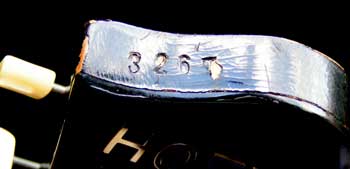
Van Wouw were Höfner’s agent in the Netherlands from the
mid-1950’s through to the early 1980’s, and they stamped the headstock top edge of all
their Höfner guitars with a serial number during the 50’s and 60’s. Unlike
Selmer, they incorporated all Höfner models into the same series of numbers.
Fully correlated records are not available now, but the following specimen
numbers with dates provide a guide for approximate dating purposes.
|
Approx Yr. |
Sample Serial Nos |
|
1960 |
1882; 1921; 2116; 2224; 2531; 3133. |
|
1961 |
3204; 3215; 3267; 3351; 3596; 3894; 3959; 4072. |
|
1962 |
4506; 4748; 5253; 5284; 5390; 5486. |
|
1964 |
7095. |
|
1965 |
7598. |
|
1966 |
8573. |
3. Wm. R. Gratz Serial Numbers:
Throughout the 1960s
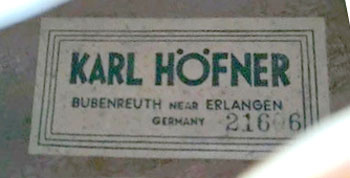 |
Wm. Gratz Serial |
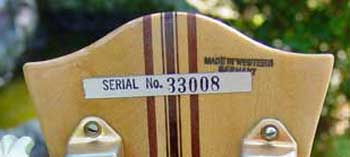 |
|
Wm Gratz was Hӧfner’s distributor in the USA following
the Second World War until 1970 when the Multivox/Sorkin Company took over the
distributorship, as well as ownership of the Höfner trade mark in the US. On
some of the Gratz guitars of this period, serial numbers can be found on labels
attached to the rear of the headstock. These labels tend to be white with black
print, and have the words “SERIAL No.” included before the 5-digit number. A few
early archtops have body labels as also shown above. These two types of labels
with their numbering system were applied in the US either by Gratz themselves or possibly by one of
the companies in that country that they supplied to such as Sorkin.
Examples of these allocated to years are provided below
as a very approximate guide:
|
Approx Year |
Serial No. |
|
1965 |
25000 |
|
1966 |
30000-40000 |
|
1967 |
40000 – 60000 |
|
1968 |
60000 – 80000 |
4. Multivox/Sorkin
Serial Numbers: 1970-85
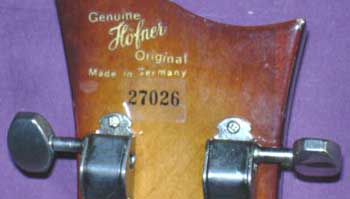
Multivox/Sorkin, who were the exclusive Höfner
distributors in the US from 1970 through to 1985, also instituted their own
system of serial numbers for all instruments, including Höfner guitars and
basses. Transparent adhesive labels with the serial number printed in black
figures were stuck onto the rear of the headstock. Many guitars sold in the US
during this period however do not have this label, and so it must be assumed
that either Sorkin/Multivox were not rigorous in this practice, or that the
labels became detached from the headstocks over time.
These serial numbers tend to be a maximum of five
numerical digits, and examples with approximate dates are provided below:
|
Approx Year |
Serial No. |
|
1973 |
2700 |
|
Mid/late 1970’s |
11300 |
|
C1980 |
13400 |
|
1984 |
27000 |
5. Swedish Model &
Date Codes
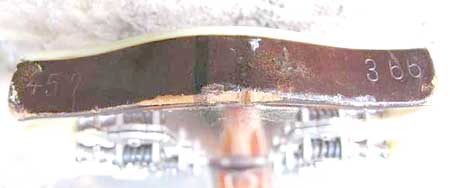
Höfners were sold on the Swedish
market by the distributor Muskantor during the 1960’s, and these were also given
a degree of identification by means of stamping the model number and a date code
into the top edge of the headstock. As an example “5001
1162” would indicate a 500/1 bass guitar that
was logged into the Swedish distributor’s warehouse during November 1962.
Obviously these markings cannot really be considered to be a serial number, as
more than one instrument would have the same numbers. They do however help with
the dating of a guitar with such markings.
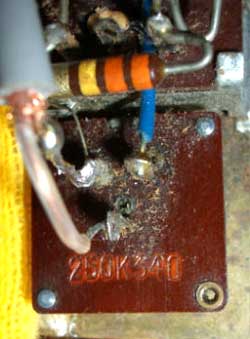
If one has an electric archtop from the 1950’s
or 60’s, and fitted with a rectangular control console, then it should have a
date-related pot code on each volume potentiometer which can easily be examined
by again carefully removing the console from the body top and examining the
bases of the pots. Those early guitars fitted with two rotary volume and two
rotary tone controls mounted on the oval or round control consoles are much more
difficult to inspect due to the need to unscrew the retaining nuts of all the
potentiometers before dismantling the console. If you do decide to proceed with
this type of console, then remember that you will still have to get the whole
thing back together again inside the small routing in the body top! The later
guitars with body mounted controls are not much easier to examine!
The pot codes were stamped into the brown
fibreboard base plates of each of the volume and tone potentiometers, which were
made by the German company Preh. The Preh pots were used from the mid-1950’s
through to around 1973. Potentiometers on guitars made after 1973 generally do
not have meaningful pot codes.
The pot codes usually
have the form such as “250K 340”. The “250K”part of the code relates to the
electrical resistance of the potentiometer, and has no relevance to dating. The
“340” indicates that the potentiometer was manufactured on the 34th
week of 1960 or 1970.
A pot code of “250K 168”
would indicate a date of 16th week of 1958 or 1968.
Some pot codes only have
two-digit date codes, such as say “250K 89”. That would indicate a date of the 8th
week of 1959 or 1969.
Around late 1959, some
codes have a “S” appended to the end of date code, such as “250K 459S” It is not
known what the “S” represents, but a dating of in this case 45th
week of 1959 can safely be assumed.
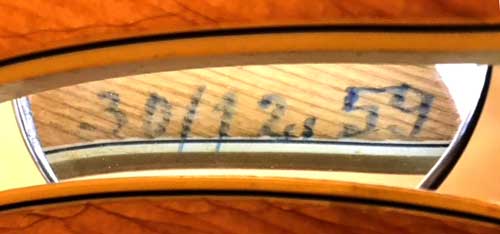
In the 1950’s, the practice of writing, or in
later cases stamping, a date onto the inside face of the body tops of Höfner
hollow-bodied guitars was commonplace during assembly of the body. It wasn’t
done on every body top however, and during the early to mid-1960s, the practice
became less prevalent and then died out altogether. Therefore, if your guitar
doesn’t have one, don’t worry!
In order to look for a date, use a flexi-torch
for illumination and then look under the body top using a small dentist’s mirror
inserted through the sound hole. Usually, the date (if there is one) is located
close to the bass-side sound hole.
Höfner had a policy of on-going improvement with all their
instruments and with the individual components of the instruments. Pickups in
particular improved markedly during the late-1950s & 60s, perhaps because
Walter Höfner seems to have been fascinated by all aspects of guitar electrics.
Indeed, Walter designed the “Black-Bar” pickup which was the first pickup type,
(together with metal-cased Fuma-made units), to be used consistently on Höfner
guitars in the mid-1950’s. He then continued to oversee the development
of most of the other types used on his guitars in the following two decades. In
doing this, he teamed up with an electrical engineer in nearby Erlangen, called
Franz Pix. Franz took over production of Walter’s Black-Bar pickup in 1958, and
from then on, his workshops were closely associated with many of the pickups
used on Höfner guitars and basses up until the 1990’s. Pix also assisted in the
design and supply of the famous Höfner rectangular control console and active
electrical circuits that Walter Höfner pioneered throughout the 1960’s.
As soon as a new pickup had been developed during the
1960’s by Walter Höfner and/or Franz Pix, this would be adopted throughout the
whole range of guitars and basses of that period. There were a few exceptions to
this, particularly on some of the budget archtops and thinline models, which
seem to have continued to use the Type 510 (Diamond Logo) and the Type 511
(Staple) designs for a time after the majority of models had switched over to
new and better pickups. This however was presumably for cost reasons and also in
order to use up stocks of the old pickups.
From early in the 1970’s, a wider range of pickups began to
appear, with units described as “Hi-Fi” and “Studio”. These were often offered
as optional alternatives to the standard Hofner pickups on some guitar models.
The Schaller Company from the near-by town of Feucht produced many of these,
again fitting in with the pattern of Höfner using local suppliers.
From the mid-1970’s, the use of Höfner/Pix pickups seems to
have been confined to the Hofner bass guitars, with Schaller being pre-dominant
for the archtops, thinlines, and semis. However,
during the 1980’s, a few non-German pickups such as DiMarzio and Seymour Duncan
were used, generally speaking as options to Schaller units.
The development of the Attila Zoller model in the early 1980’s
introduced Höfner to German Shadow pickups, and these were used on a few of the
later A2L archtops and the AZ models, as well as the first version of the
Jazzica.
For the later post-2000 guitars, Kent Armstrong appears to
have been involved with the design of the mini-humbucking pickups developed for
such models as the New President and Verythin. However, as previously, Schaller
actually made these pickups, and they still continue to dominate during the
present day.
The following are pictures of the most common pickup units
fitted by Höfner to their archtop and thinline guitars throughout the years:
·
Fuma
Single Coil Pickup (1953 – 58)
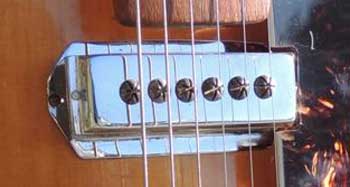
·
Hofner
Black Bar Pickup – Rosewood Case (1955-1958)
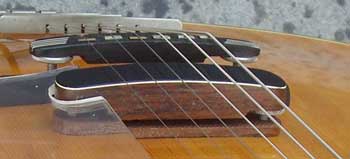
· Höfner
Black Bar Pickup – Plastic Case (1958-1959) - Made by Franz Pix
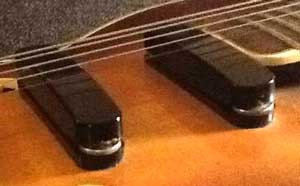
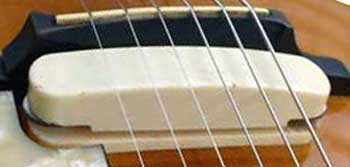
·
Höfner
“Toaster” Single Coil Pickup (1960-1961) – Made by Franz Pix
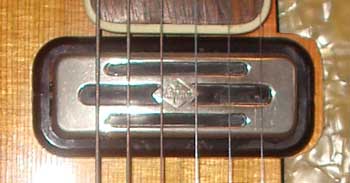
·
Höfner
Type 510 “Diamond Logo” Single Coil Pickup (1961 – generally 1962, although
this pickup did continue to be fitted to the lower price range archtops for
several years after.) – Made by Franz Pix (Note: A very small number
of Type 510 units have been found to have twin coils like the Type 511 “Super”
pickups below.)
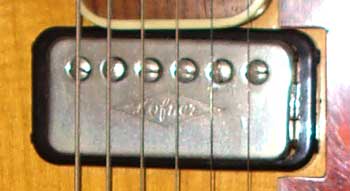
·
Höfner
Type 511(i) “Diamond Logo Super” Twin Coil Pickup (1962-1963) – Made by
Franz Pix
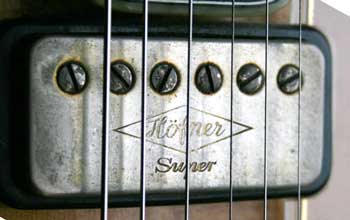
·
Höfner
Type 511(ii) “Staple” Twin Coil Pickup (1963- generally 1967, although some
thinline guitars continued to be fitted with this pickup until the early
1970’s.) – Made by Franz Pix
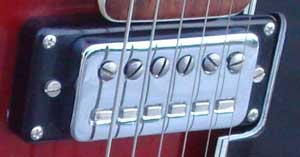
·
Höfner
Type 513 “Blade” Single Coil/Twin Pole Pickup (1967 – Mid 1970’s ) – Made by
Franz Pix (Note: A very similar unit
to this was also made by Schaller from the late 1960’s onwards.)
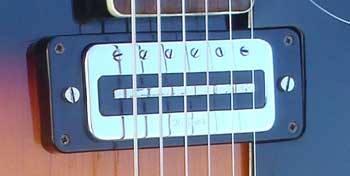
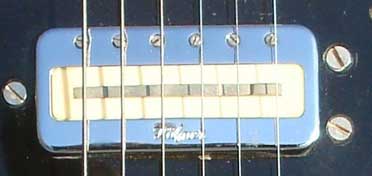
·
Hofner
Type 511(iii) Single Coil Pickup (1971 – 1980’s) – Made by Schaller
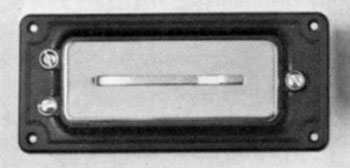
·
Hofner
Type 514 “Hi-Fi” Pickup (1971- 78) – Made by Schaller
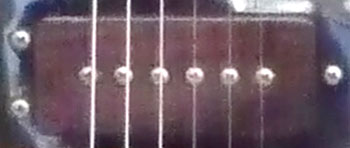
·
Hofner
Type 515 “Mini-Humbucker” Twin Coil Pickup (1971- 78) – Made by Schaller
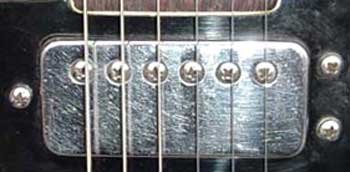
·
Hofner
Type 516 “Fullsize-Humbucker” Twin Coil Pickup (c1973- 1980’s) – Made by
Schaller
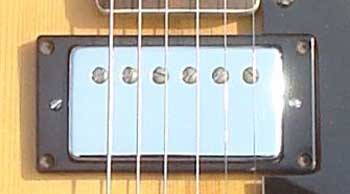
·
Shadow-made “Attila Zoller” Floating Single Coil Pickups (1982-c1995)
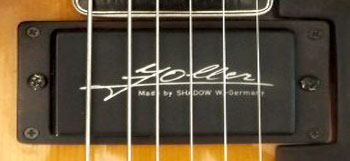
·
Hofner
Type 514/Kent Armstrong “Diamond” Mini-Humbucking Pickups (1998 - Present
Day)
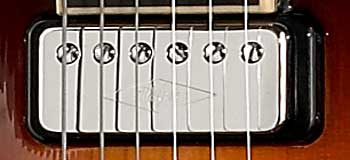
·
Hofner
Type 515 Full-Sized Humbucking Pickups (2005 – Present Day) – Made by
Schaller
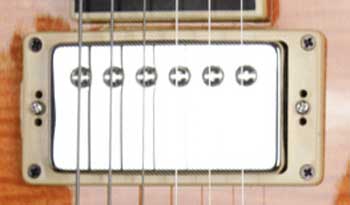
E. DATEABLE IDENTIFICATION
FEATURES
Note: These features are intended to give only
general pointers to establishing a guitar’s approximate age. Höfner as a company
did not always work to strict specifications, and hence there are many anomalies
in the matters of detail of their products.
|
Approx Dates |
Feature |
|
Up to c1953 |
Flared top headstocks fitted to many of the archtop
models. |
|
Up to c1953 |
Purfling around body edges does not have side
binding on some archtop models. |
|
Up to early 1956 |
Body logo stamped into top of body adjacent to
bridge. A decal-type logo applied on the top bass bout was then adopted
from 1956 until c1963 for most archtops. |
|
Early 1956 |
Separate maple pieces used for neck cantilevers
instead of being integral with neck timbers. |
|
Up to 1957 |
No Höfner logo on headstock, only on body. From
1957 onwards, various styles of Höfner logo appeared fairly consistently
on headstocks. |
|
Mid-1958 |
Round/Oval control console on electric archtops
replaced by rectangular console. |
|
January 1960 |
Commencement of fitting truss rods to necks. |
|
Between Late 1950’s & Early 60’s |
Use of solid carved spruce body tops for
higher-grade archtops abandoned progressively by Höfner. |
|
Early 1960’s |
Practice of marking dates under body tops gradually
abandoned. |
|
Early 1962 |
Rectangular control console replaced by individual
control knobs on electric guitars. |
|
1962/63 |
Höfner decal-type logo on body discontinued. (Note
the use of these logos was also intermittent on some models up to that
time.) |
|
Mid-1965 |
Previous narrow plastic pickup surrounds replaced
by wide “Gibson-style” surrounds with vertical screw adjustment. |
|
From late 1960’s |
“Genuine Höfner…..” guarantee decal applied to rear
of headstocks. |
|
Late 1960’s |
Nitrocellulose finishes replace by polyethylene. |
|
Late 1960’s |
Truss rod cover shape changed from triangular
curved shape to a more bell-shaped profile. |
|
Late 1990’s |
Return to nitrocellulose finishes for German-made
archtops. |
|
2012 |
Hofner 125th Anniversary logo on rear of
headstocks. |
_________________________________________________
Copyright
© 2022 Steve Russell. All Rights Reserved